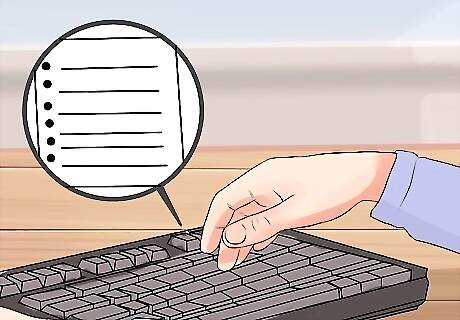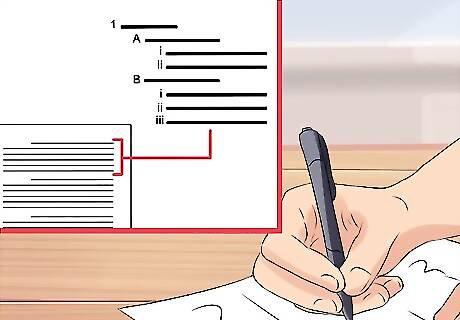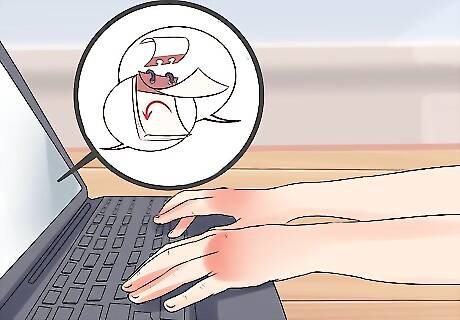
views
Preparing to Write Your Essay

Evaluate the essay question. The first thing to do if you have a history essay to write, is to really spend some time evaluating the question you are being asked. No matter how well-written, well-argued, or well-evidenced your essay is, if you don't answer the answer the question you have been asked, you cannot expect to receive a top mark. Think about the specific key words and phrasing used in the question, and if you are uncertain of any of the terms, look them up and define them. The key words will often need to be defined at the start of your essay, and will serve as its boundaries. For example, if the question was "To what extent was the First World War a Total War?", the key terms are "First World War", and "Total War". Do this before you begin conducting your research to ensure that your reading is closely focussed to the question and you don't waste time.

Consider what the question is asking you. With a history essay there are a number of different types of question you might be asked, which will require different responses from you. You need to get this clear in the early stages so you can prepare your essay in the best way. Look at your set essay question and ask yourself whether you are being asked to explain, interpret, evaluate, or argue. You might be asked to do any number or all of these different things in the essay, so think about how you can do the following: Explain: provide an explanation of why something happened or didn't happen. Interpret: analyse information within a larger framework to contextualise it. Evaluate: present and support a value-judgement. Argue: take a clear position on a debate and justify it.

Try to summarise your key argument. Once you have done some research you will be beginning to formulate your argument, or thesis statement, in your head. It's essential to have a strong argument which you will then build your essay around. So before you start to plan and draft your essay, try to summarise your key argument in one or two sentences. Your thesis statement should clearly address the essay prompt and provide supporting arguments. These supporting arguments will become body paragraphs in your essay, where you’ll elaborate and provide concrete evidence. Your argument may change or become more nuanced as your write your essay, but having a clear thesis statement which you can refer back to is very helpful. For example, your summary could be something like "The First World War was a 'total war' because civilian populations were mobilized both in the battlefield and on the home front".

Make an essay plan. Once you have evaluated the question, you need to draw up an essay plan. This is a great opportunity to organise your notes and start developing the structure which you will use for your essay. When drawing up the plan you can assess the quality and depth of the evidence you have gathered and consider whether your thesis statement is adequately supported. Pick out some key quotes that make your argument precisely and persuasively. When writing your plan, you should already be thinking about how your essay will flow, and how each point will connect together.
Doing Your Research

Distinguish between primary and secondary sources. A history essay will require a strong argument that is backed up by solid evidence. The two main types of evidence you can draw on are known as primary and secondary sources. Depending on the essay you are writing, you might be expected to include both of these. If you are uncertain about what is expected be sure to ask your teacher well in advance of the essay due date. Primary source material refers to any texts, films, pictures, or any other kind of evidence that was produced in the historical period, or by someone who participated in the events of the period, that you are writing about. Secondary material is the work by historians or other writers analysing events in the past. The body of historical work on a period or event is known as the historiography. It is not unusual to write a literature review or historiographical essay which does not directly draw on primary material. Typically a research essay would need significant primary material.

Find your sources. It can be difficult to get going with your research. There may be an enormous number of texts which makes it hard to know where to start, or maybe you are really struggling to find relevant material. In either case, there are some tried and tested ways to find reliable source material for your essay. Start with the core texts in your reading list or course bibliography. Your teacher will have carefully selected these so you should start there. Look in footnotes and bibliographies. When you are reading be sure to pay attention to the footnotes and bibliographies which can guide you to further sources a give you a clear picture of the important texts. Use the library. If you have access to a library at your school or college, be sure to make the most of it. Search online catalogues and speak to librarians. Access online journal databases. If you are in college it is likely that you will have access to academic journals online. These are an excellent and easy to navigate resources. Use online sources with discretion. Try using free scholarly databases, like Google Scholar, which offer quality academic sources, but avoid using the non-trustworthy websites that come up when you simply search your topic online. Avoid using crowd-sourced sites like Wikipedia as sources. However, you can look at the sources cited on a Wikipedia page and use them instead, if they seem credible.

Evaluate your secondary sources. It's very important that you critically evaluate your sources. For a strong academic essay you should be using and engaging with scholarly material that is of a demonstrable quality. It's very easy to find information on the internet, or in popular histories, but you should be using academic texts by historians. If you are early on in your studies you might not be sure how to identify scholarly sources, so when you find a text ask yourself the following questions: Who is the author? Is it written by an academic with a position at a University? Search for the author online. Who is the publisher? Is the book published by an established academic press? Look in the cover to check the publisher, if it is published by a University Press that is a good sign. If it's an article, where is published? If you are using an article check that it has been published in an academic journal. If the article is online, what is the URL? Government sources with .gov addresses are good sources, as are .edu sites.

Read critically. Once you found some good sources, you need to take good notes and read the texts critically. Try not to let your mind drift along as you read a book or article, instead keep asking questions about what you are reading. Think about what exactly the author is saying, and how well the argument is supported by the evidence. Ask yourself why the author is making this argument. Evaluate the text by placing it into a broader intellectual context. Is it part of a certain tradition in historiography? Is it a response to a particular idea? Consider where there are weaknesses and limitations to the argument. Always keep a critical mindset and try to identify areas where you think the argument is overly stretched or the evidence doesn't match the author's claims.

Take thorough notes. When you are taking notes you should be wary of writing incomplete notes or misquoting a text. It's better to write down more in your notes than you think you will need than not have enough and find yourself frantically looking back through a book. Label all your notes with the page numbers and precise bibliographic information on the source. If you have a quote but can't remember where you found it, imagine trying to skip back through everything you have read to find that one line. If you use something and don't reference it fully you risk plagiarism.
Writing the Introduction

Start with a strong first sentence. When you begin writing up your essay, a strong introduction can set the scene, create interest in the reader, and provide an outline of what is to come in your essay. Try to begin with one or two sentences which announce the topic of your essay and indicate what you will be writing about. The first sentence or two can give a broader view of a problem which you will then focus in on in the rest of the introduction. For example you could start by saying "In the First World War new technologies and the mass mobilization of populations meant that the war was not fought solely by standing armies". This first sentences introduces the topic of your essay in a broad way which you can start focus to in on more.

Outline what you are going to argue. In your introduction you should give a clear outline of how you are going to answer the question, and what your argument is. You should give a brief overview of your main points and the type of evidence that you will use to support them. Try to explicitly answer the question in one sentence, and then expand on how you are going to argue your case. This will lead to an outline of the structure of your essay and your argument. Here you will explain the particular approach you have taken to the essay. For example, if you are using case studies you should explain this and give a brief overview of which case studies you will be using and why.

Provide some brief context for your work. Depending on the type of essay you are writing, it will be necessary to provide a brief overview of the main historiographical debates for your topic. It is important to demonstrate that you have a good understanding of what other historians have written about your topic, and be able to situate your own argument within this broader context.
Writing the Essay

Have a clear structure. When you come to write the body of the essay it is important that you have a clear structure to your argument and to your prose. If your essay drifts, loses focus, or becomes a narrative of events then you will find your grade dropping. Your introduction can help guide you if you have given a clear indication of the structure of your essay.

Develop your argument. The body of the essay is where your argument is really made and where you will be using evidence directly. Think carefully about how you construct your paragraphs, and think of each paragraph as one micro-sized version of the essay structure. In other words, aim to have a topic sentence introducing each paragraph, followed by the main portion of the paragraph where you explain yourself and draw on the relevant evidence. Try to include a sentence that concludes each paragraph and links it to the next paragraph. When you are organising your essay think of each paragraph as addressing one element of the essay question. Keeping a close focus like this will also help you avoid drifting away from the topic of the essay and will encourage you to write in precise and concise prose. Don't forget to write in the past tense when referring to something that has already happened.

Use source material as evidence to back up your thesis. Your evidence will be the heart of your history essay. Introduce your different pieces of evidence by directly quoting them, or by summarising them. Then, analyze them in a way that ties back to and supports your thesis statement. Don't drop a quote from a primary source into your prose without introducing it and discussing it, and try to avoid long quotations. Use only the quotes that best illustrate your point. If you are referring to a secondary source, you can usually summarise in your own words rather than quoting directly. Be sure to fully cite anything you refer to, including if you do not quote it directly.

Make your essay flow. The fluency of your text is an important element in the writing a good history essay that can often be overlooked. Think carefully about how you transition from one paragraph to the next and try to link your points together, building your argument as you go. It is easy to end up with an essay that reads as a more or less disconnected series of points, rather than a fully developed and connected argument. Think about the first and last sentence in every paragraph and how they connect to the previous and next paragraph. Try to avoid beginning paragraphs with simple phrases that make your essay appear more like a list. For example, limit your use of words like: "Additionally", "Moreover", "Furthermore". Give an indication of where your essay is going and how you are building on what you have already said.

Conclude succinctly. A good conclusion should precisely and succinctly summarise your argument and key points. You need to make sure your conclusion reflects the content of your essay, and refers back to the outline you provided in the introduction. If you read your conclusion and it doesn't directly answer the essay question you need to think again. Briefly outline the implications of your argument and it's significance in relation to the historiography, but avoid grand sweeping statements. A conclusion also provides the opportunity to point to areas beyond the scope of your essay where the research could be developed in the future.
Proofreading and Evaluating Your Essay

Proofread your essay. Once you have written up essay, it is important that you set aside sometime to proofread it thoroughly and work on any revisions. Proofreading is not just about picking out typos and grammar mistakes, but can be a good opportunity to evaluate your work more closely, both for style and content. As you read through, think about the language you use as well as your sentence construction. Try to cut down any overly long sentences or run-on sentences. Instead, try to write clear and accurate prose and avoid unnecessary words. Concentrate on developing a clear, simple and highly readable prose style first before you think about developing your writing further. Reading your essay out load can help you get a clearer picture of awkward phrasing and overly long sentences.

Analyse don't describe. One thing to look out for when you read through your history essay is whether or not you have allowed any overly descriptive passages to creep in. Remember a history essay is an analysis and not just a narrative of events. History students can find themselves re-telling a series of events rather than analysing them and the historiographical debates about them. When you read through your essay look at each paragraph and ask yourself, "what point this paragraph is making". You might have produced a nice piece of narrative writing, but if you are not directly answering the question it is not going to help your grade.

Check your references and bibliography. Your essay is not complete until you have included and checked all your references together with your bibliography. There are many different style conventions for the formatting of these, so be sure to check with your teacher what style you should be using if you don't already know. Although it might seem like an annoying task, if you don't use the right style it suggests laziness to the person marking your essay. A bibliography will typically have primary sources first, followed by secondary sources. Double and triple check that you have included all the necessary references in the text. If you forgot to include a reference you risk being reported for plagiarism.



















Comments
0 comment